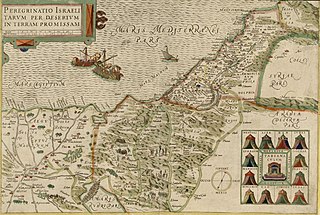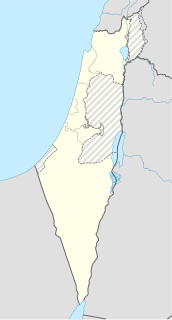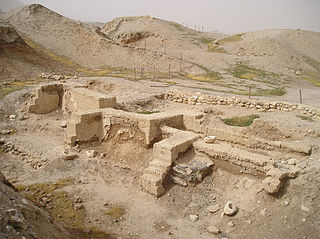
The Book of Exodus is the second book of the Bible. It narrates the story of the Exodus, in which the Israelites leave slavery in Biblical Egypt through the strength of Yahweh, the god who has chosen them as his people. The Israelites then journey with the prophet Moses to Mount Sinai, where Yahweh promises them the land of Canaan in return for their faithfulness. There, they enter into a covenant with Yahweh, who gives them their laws and instructions to build the Tabernacle, the means by which he will come from heaven and dwell with them and lead them in a holy war to possess the land, and then give them peace.

The Kingdom of Judah was an Israelite kingdom of the Southern Levant during the Iron Age. It was centered in the region of Judea, and its capital was Jerusalem. The other Israelite polity, the Kingdom of Israel, lay to the north. Modern Jews are named after and also descended from the Kingdom of Judah.

The Kingdom of Israel or the Kingdom of Samaria was an Israelite kingdom of the Southern Levant during the Iron Age. The kingdom controlled the regions of Samaria, Galilee and parts of the Transjordan. Its capital, for the most part, was Samaria. The other Israelite polity, the Kingdom of Judah, lay to the south.

The Israelites were a confederation of Iron Age Semitic-speaking tribes of the ancient Near East, who inhabited a part of Canaan during the tribal and monarchic periods.

The historicity of the Bible is the question of the Bible's relationship to history—covering not just the Bible's acceptability as history but also the ability to understand the literary forms of biblical narrative. One can extend biblical historicity to the evaluation of whether or not the Christian New Testament is an accurate record of the historical Jesus and of the Apostolic Age. This tends to vary depending upon the opinion of the scholar.

William Foxwell Albright was an American archaeologist, biblical scholar, philologist, and expert on ceramics.

Manasseh was the fourteenth king of the Kingdom of Judah. He was the oldest of the sons of Hezekiah and his mother Hephzibah. He became king at the age of 12 and reigned for 55 years.

Josiah or Yoshiyahu was the 16th king of Judah who, according to the Hebrew Bible, instituted major religious reforms by removing official worship of gods other than Yahweh. Josiah is credited by most biblical scholars with having established or compiled important Hebrew scriptures during the “Deuteronomic reform” which probably occurred during his rule. Josiah became king of the Kingdom of Judah at the age of eight, after the assassination of his father, King Amon. Josiah reigned for 31 years, from 641/640 to 610/609 BCE.

Israel Finkelstein is an Israeli archaeologist, professor emeritus at Tel Aviv University. Finkelstein is active in the archaeology of the Levant and is an applicant of archaeological data in reconstructing biblical history. He is also known for applying the exact and life sciences in archaeological and historical reconstruction. Finkelstein is the current excavator of Megiddo, a key site for the study of the Bronze and Iron Ages in the Levant.

The United Monarchy is the name given to the united Israelite kingdom of Israel and Judah during the reigns of Saul, David and Solomon, as depicted in the Hebrew Bible. It is traditionally dated to have lasted between 1047 BCE and 930 BCE. On the succession of Solomon's son Rehoboam in c. 930 BCE, the Biblical account reports that the country split into two kingdoms: the Kingdom of Israel in the north and the Kingdom of Judah in the south.
An Asherah pole is a sacred tree or pole that stood near Canaanite religious locations to honor the Ugaritic mother goddess Asherah, consort of El. The relation of the literary references to an asherah and archaeological finds of Judaean pillar-figurines has engendered a literature of debate.

Abdi-Heba was a local chieftain of Jerusalem during the Amarna period. Abdi-Heba's name can be translated as "servant of Hebat", a Hurrian goddess. Whether Abdi-Heba was himself of Hurrian descent is unknown, as is the relationship between the general populace of pre-Israelite Jerusalem and the Hurrians. Egyptian documents have him deny he was a mayor (ḫazānu) and assert he is a soldier (we'w), the implication being he was the son of a local chief sent to Egypt to receive military training there.

The Stations of the Exodus are the locations visited by the Israelites following their exodus from Egypt, according to the Hebrew Bible. In the itinerary given in Numbers 33, forty-two stations are listed, although this list differs slightly from the narrative account of the journey found in Exodus and Deuteronomy.

The Bible Unearthed: Archaeology's New Vision of Ancient Israel and the Origin of Its Sacred Texts, a book published in 2001, discusses the archaeology of Israel and its relationship to the origins and content of the Hebrew Bible. The authors are Israel Finkelstein, Professor of Archaeology at Tel Aviv University, and Neil Asher Silberman, an archaeologist, historian and contributing editor to Archaeology Magazine.
Israelite highland settlement refers to ancient Israelite settlement in the highlands north of Jerusalem discovered in archaeological field surveys conducted in Israel since the 1970s.

Meṣad Hashavyahu is an ancient fortress on the border of the ancient Kingdom of Judah facing the Philistine city of Ashdod near the Mediterranean Sea. It lies 1.7 km south of Yavne-Yam and 7 km northwest of Yavne. The original name of the fort is unknown, but was given the name found on several inscribed pottery shards (ostraca) recovered at the site. The site covers an area of approximately 1.5 acres (6,100 m2).

Levantine archaeology is the archaeological study of the Levant. It is also known as Syro-Palestinian archaeology or Palestinian archaeology. Besides its importance to the discipline of Biblical archaeology, the Levant is highly important when forming an understanding of the history of the earliest peoples of the Stone Age.

Avraham Biran was an Israeli archaeologist, best known for heading excavations at Tel Dan in northern Israel. He headed the Institute of Archaeology at Hebrew Union College in Jerusalem for many years.

This article is an overview of the kings of the United Kingdom of Israel as well as those of its successor states and classical period kingdoms ruled by the Hasmonean dynasty and Herodian dynasty.
The Message and the Kingdom: How Jesus and Paul Ignited a Revolution and Transformed the Ancient World is a 1997 book by the Americans New Testament scholar from the University of Massachusetts Boston, Richard A. Horsley and Neil Asher Silberman, an archaeologist, historian and contributing editor to Archaeology Magazine. It is a historical account of Christianity in the 1st century that portrays the quest for the kingdom of God by Jesus, Paul, and the earliest churches as both a spiritual journey and a political response to the "mindless acts of violence, inequality, and injustice that characterized the kings of men."















